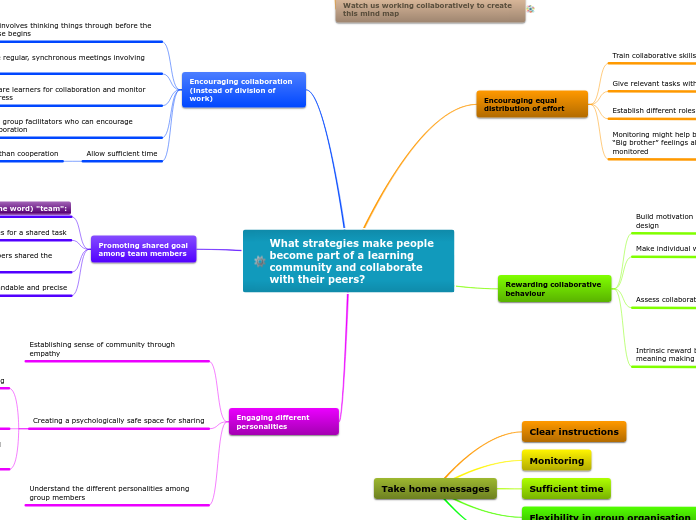作者:Victoria Marin 5 年以前
230
What strategies make people become part of a learning community and collaborate with their peers?

PBL Group 9 - Topic 3
Watch us working collaboratively to create this mind map
Take home messages
Encourage communication
Flexibility in group organisation
Sufficient time
Monitoring
Clear instructions
What strategies make people become part of a learning community and collaborate with their peers?
Engaging different personalities
Understand the different personalities among group members
Creating a psychologically safe space for sharing
Allows learners to choose the level of privacy of their conversations (public, class, restricted)
Allow flexibility to stimulate creativity in group organisation (e.g. tools, roles)
Form groups early to allow bounding
Establishing sense of community through empathy
Promoting shared goal among team members
Goal must be understandable and precise
Teams succeed when all members shared the same goal
Establish roles/responsibilities for a shared task
There is no (letter) "I" in (the word) "team":
Encouraging collaboration (instead of division of work)
Allow sufficient time
True collaboration takes longer than cooperation
Have group facilitators who can encourage collaboration
Prepare learners for collaboration and monitor progress
Encourage & enable regular, synchronous meetings involving the whole group
This involves thinking things through before the course begins
Rewarding collaborative behaviour
Intrinsic reward by assignments that allow for meaning making - pass or fail?
Assess collaboration by grading?
Collaboration as part of the assessment
Coherent assessment to minimise unfairness
According to Brindley et al., this may not help
Make individual work dependent on group work
Build motivation for collaboration into the course design
Encouraging equal distribution of effort
Monitoring might help but with the risk of “Big brother” feelings about being monitored
Establish different roles for a shared task
Give relevant tasks with clear guidelines
Assign tasks that are appropriate for groups to work on together
Train collaborative skills in academic settings

